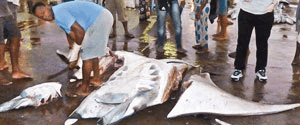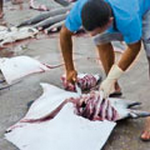CITES and Indonesia: So why care about a ‘fish’?
Dr. Stamps Howard,Appeared in Ceylon Today on Saturday, 03 Aug 2013
Majestic maduwa
 Last week, one of us spoke at the Lakshman Kadirgarmar Institute's important event
titled 'The hidden gold mine of Sri Lanka's ocean resources.' The "maduwa" – or
Oceanic Manta Ray – is one such valuable Sri Lankan ocean resource. The talk raised
its drastic decline in Sri Lanka and elsewhere.
Last week, one of us spoke at the Lakshman Kadirgarmar Institute's important event
titled 'The hidden gold mine of Sri Lanka's ocean resources.' The "maduwa" – or
Oceanic Manta Ray – is one such valuable Sri Lankan ocean resource. The talk raised
its drastic decline in Sri Lanka and elsewhere.
This week, in Bangkok, at the Conference of the Parties on the Convention on International Trade in Endangered Species (CITES), Sri Lanka has a chance to vote on doing something to stop that decline. Brazil, Columbia and Ecuador have proposed to add manta rays to the list of species protected in international trade under CITES. We think Sri Lanka should vote "Yes." Legally and economically, the proposal makes sense.
Second largest exporter
Sri Lanka is the world's second largest exporter of dried manta gills largely for the Chinese medicinal trade according to a 2012 report by Manta Ray of Hope, a consortium of scientific experts and NGOs working to protect the manta. The report indicates Sri Lanka slaughters over 1055 a year for this trade, ranking just behind Indonesia (1320), and almost doubles that of India (690), who sits in third place. Manta gill plates now sell for upwards of Rs. 85,000 per kg in Guanzhou, China, where 99 percent of the market ends up. These high prices lead many fishers and traders to seek to supply the market, and many traders to work as "market-makers" to further stimulate demand.
Legally, the Manta proposal submitted to CITES makes sense, because it tracks the growing tenor of Asian consensus, and Sri Lanka's existing national and international obligations. Among other countries, the Philippines has an Executive Order protecting Mantas, and prohibiting their slaughter and export. The Maldives also has a law banning the export of Manta products. In February this year, Indonesia banned manta fishing in a new 46,000 km shark and manta ray sanctuary in Raja Ampat.
As a signatory to CITES, if two thirds of countries at the meeting vote in favour of the Manta proposal, Sri Lanka will have to introduce a permit system for the export of manta ray gills. However, Sri Lankan law already requires such an export system, even without legally protecting the manta. Export permits for all indigenous "fish" are legally required under section 40(1) of Sri Lanka's Fauna and Fauna Protection Act (FFPA). Hence, current exports of manta gills, which occur without these permits, are illegal. If CITES endorses the Manta proposal, the main change for Sri Lanka would be to clearly protect the manta under Sri Lankan law – presumably by adding it to the list of protected species under the FFPA.

Such changes are consistent with Sri Lanka's existing international legal obligations. In November 2011, Sri Lanka, along with India, Pakistan and the Philippines and 17 other countries, agreed to list the manta ray as covered by the Convention on Migratory Species (CMS), which supports international cooperation for the protection of migratory species amongst the nations through which they migrate. This listing requires Sri Lanka to try to immediately protect the Manta, and to work with other states to conclude more detailed agreements for its conservation and management.
Economically, although Sri Lanka is a large exporter of manta ray gill plates, and the CITES proposal would regulate their export, the manta ray proposal also makes economic sense. First, regulating the trade will promote sustainability and second Sri Lanka stands to gain from potentially significant tourism revenues, if the CITES listing is a step to further national protections.
Legal Obligations
Currently, Sri Lankan fisherman selling gill plates get cash amounting to only about 20% of the retail sale value. More than 80% of the profits go to the international traders, and to the Chinese retailers.
Sri Lankan fishermen get different cash prices depending on whether the Manta is small (say Rs. 3,000), medium (say Rs. 15,000), or very large (Rs. 50,000), with the average being medium - about 270 cm – giving the fisher about Rs. 12,500. But in China, the gill plates of the same manta might get five times that amount. Thus, Sri Lankan "hidden gold" ocean resources are being locally decimated to enrich the pockets of foreign traders and retailers.
And the current high prices, are leading to exploitation of this hidden resource at a rate that is entirely unsustainable and will lead to their complete demise within years, like other similar species. The Sri Lankan shark fishery, for example, declined by about 87 percent from 2000 to 2008, from about 34,380 to 4410 sharks. How long until manta rays suffer the same decline?
Sri Lanka also stands to benefit from a CITES listing and later protecting mantas at home because of tourism. If the estimated number of 1000 dead Sri Lankan mantas a year is correct, then the total annual value of these mantas sold largely to China, is roughly Rs. 1,250,000, which may seem enormous. However, as nearby scuba diving resorts in the Maldives suggest, the potential value of Manta tourism is far greater.
In Yap, Micronesia, an entire tourism industry of Rs. 500,000,000 annually is based upon tourists coming to Yap to swim and dive with Manta Rays. In Kona, Hawaii, the value of 100 tourists paying to dive or snorkel with Manta Rays each night, amounts to Rs. 60,000 each night and Rs. 2,160,000,000 a year. Although a range of other variables affect precise numbers, one thing is clear – Mantas draw scuba divers and snorkelers who pay big to see them.
Because Manta rays are a migratory ocean species, it is not enough for Sri Lanka to protect them itself, it needs Mantas to have a CITES listing to encourage other states to do the same, and ensure other states establish a permit trading system for Manta parts. At CITES, Sri Lanka's would be smart to care about mantas, and right, to vote Yes, for the giant "Maduwa.'
The views expressed are those of the authors.